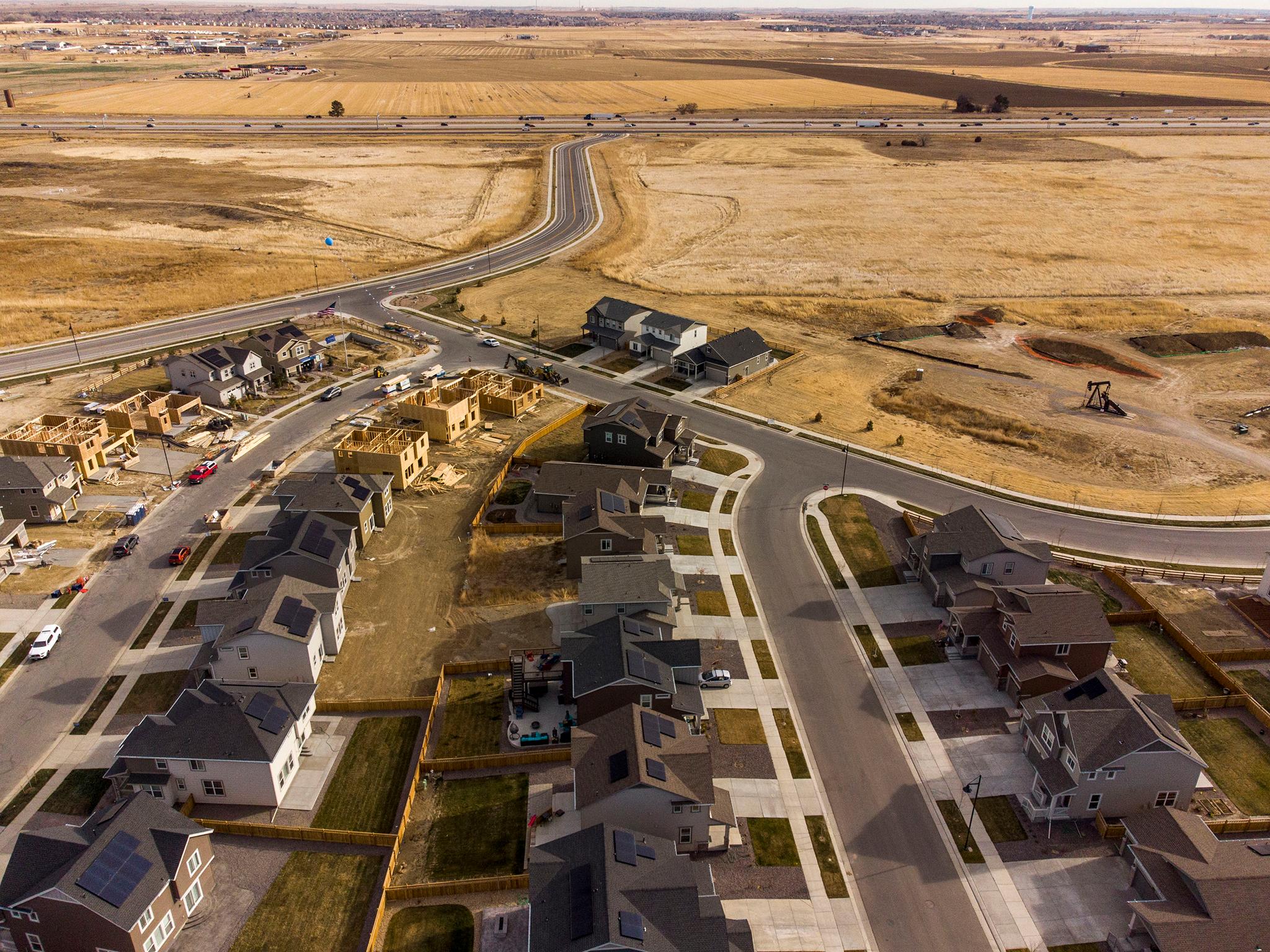
In the final weeks of the legislative session, Gov. Jared Polis will press state lawmakers to put temporary limits on the rise of property taxes.
His administration wants to temporarily reduce the state’s assessment rates, which help to determine the tax bills for residential, commercial and other property types. The change is meant to partially offset the sharp increases in property tax bills that are coming over the next two years.
In an interview, Polis framed the proposal primarily as a way to save Coloradans money — but it also is a response to pressure from outside groups, especially the business group Colorado Concern.
“We want to provide immediate relief to reduce people's property taxes, and of course, want to have a longer term discussion with the business community, with schools, with Republicans and Democrats across the state about what (property tax) mechanism we want to use long term,” Polis said.
Currently, the property taxes paid by owners across Colorado are expected to rise by close to $3 billion in tax years 2023 and 2024 — a result of higher property values. The new proposal would slow that increase. Property taxes would rise by a lower amount — keeping about $700 million in the hands of taxpayers.
Property taxes are paid to local districts, from schools to counties and cities. Colorado has some of the lowest property tax rates in the nation, but lawmakers say they’re trying to avoid sharp increases of up to 19 percent in some areas in tax year 2023.
The proposal also includes other changes to how property values are assessed and other aspects of the property tax formula.
Hot housing market drives higher property tax bills.
Every two years, county assessors recalculate the value of millions of parcels throughout the state. Skyrocketing sales prices are driving those values higher, which means that the owners owe more taxes.
In 2021, that reassessment process led to higher tax obligations across the state. In rural Elbert County, residential property values — and the taxes owed on them — went up by a median of 6 percent. In Jefferson County, it was 10 percent.
And next year’s reassessment is expected to have even greater effects. In some areas, values — and tax obligations — could grow by 19 percent, according to state Sen. Chris Hansen, who has been involved in negotiations over the property tax bill.
“There isn't a single property owner, whether it's commercial or residential, in the state that didn't have their eyes pop out of their head,” said Rep. Colin Larson, a Republican who has also been involved in the property tax debate.
The compromise proposal works in a couple ways.
The proposal Polis and state lawmakers are putting forward would amplify and extend temporary discounts that lawmakers approved last year.
This proposal would further lower the rates for 2023, and it will also keep them lower-than-normal in 2024. When the assessment rate is lowered, it reduces all properties’ bills by a certain percentage. That is a greater benefit for higher-value properties.
In addition, the proposal introduces “exemptions” for 2023. Residential and commercial properties will have their assessed values temporarily reduced that year by a set dollar amount — $10,000 for residential, $30,000 for commercial. That ultimately provides the same dollar benefit, no matter what the value of the property.
Because property tax rates are set by a combination of local and statewide factors, the bottom-line impact of the savings would differ from place to place.
For example, under this year’s plan, the owner of a $500,000 home in Arvada might save about $284 in tax year 2023, or about 8.2 percent, compared to the state’s normal, permanent rates, according to calculations by CPR News. The savings would be less in 2024.
Commercial property owners, who pay much higher tax rates, would get more relief. A commercial owner in Arvada might save about $1,340, or nearly 10 percent of their bill, in 2023.
But even with the changes, property tax bills still may rise for many owners, since the reduced rates may not fully offset the increase in value in next year’s reassessment..
The temporary rate reduction will have a direct effect on the local districts that collect property taxes, such as counties and cities. When rates go down, they miss out on new revenues — or could even suffer a revenue reduction if they’re not a high-growth area.
To ease the impact, the state would pay out $400 million to local districts, partially offsetting the missing local revenue — including fully replacing any loss to schools. About half that replacement money will come from Colorado’s general fund. The other half would be taken from the pool of money that would otherwise be paid out as TABOR refunds.
Tax bills for different property types in a district with 100 mills of property taxes. Note that this table assumes stable property values in order to illustrate the rate changes. In reality, many properties will gain in value in 2023, resulting in higher bills.
| Land type | Permanent rates under state law | Proposed 2023 rates | Proposed 2024 rates |
| Taxes owed on single-family residential worth $500,000 in a district with 100 mills of property tax | $3,575 | $3,281 | $3,475 |
| Multi-family residential worth $500,000 | $3,575 | $3,281 | $3,400 |
| Commercial, industrial worth $500,000 | $14,500 | $13,113 | $14,500 |
| Agricultural worth $500,000 | $14,500 | $13,200 | $13,200 |
The Polis administration and a business group negotiated the deal.
The proposal is the result of negotiations between the governor’s administration and an influential business group, Colorado Concern. If lawmakers pass the new bill, Colorado Concern will drop its own effort to slow down property taxes.
The group set the debate in motion earlier this year, when it announced a ballot proposal that, if it were eventually approved by voters this fall, would generally limit the rise in property tax bills to 3 percent each year for at least the next ten years. That measure could have deflected $1.3 billion of new revenues in a single year — far more than the new proposal.
In the interview on Sunday, Polis skirted around questions about the negotiations with Colorado Concern, saying the final measure was a response to other proposals “from the left and right,” too.
“Those were legitimate concerns and they had different proposals and different solutions,” he said. “There’s, I think, close to a dozen different initiatives, but I think that they were all reacting to very legitimate issues.”
The conversations included schools, the Denver Chamber of Commerce and others, Polis said. But the people pushing some of those other property tax proposals — including leaders of the progressive Bell Policy Center and the conservative Advance Colorado Institute — say they were not actually at the table.
“No, not really. We kind of knew that Concern was negotiating it and we just waited to find out what would happen,” said Michael Fields of Advance Colorado Institute.
However, Fields said that if the final proposal passes the legislature, he would likely back off of his own tax limiting measure.
Similarly, Scott Wasserman, president of Bell Policy Center, said he found some things to like in the final proposal.
“I think from the get-go, we wanted to see something that was temporary, that was targeted and that was fairly paid for,” he said.
The Polis administration proposal is limited to only two tax years, and its design means that people with lower-value properties will see a slightly larger percentage reduction on their tax bills.
Still, Wasserman complained Democratic leaders are too willing to pass laws in response to outside pressure.
“This is just a really terrible way of doing this kind of business, and it sets a really bad precedent where any group with a lot of money can throw a temper tantrum, put something on the ballot … get the attention of policymakers and make a deal,” he said.
Wasserman cast doubt on the idea that Colorado Concern could have actually convinced voters to pass its ballot initiative, since the measure may have had to include politically damaging language about how it would affect local districts.
Mike Kopp, a former state senator and the CEO of Colorado Concern, said in a statement that his group was focused on “simpler and more predictable” property taxes.
“The Governor and many in the legislature are focused on similar objectives and, with a little luck, our objectives will overlap and we will not need to proceed with a ballot measure,” Kopp said.
Sen. Chris Hansen, a Democratic sponsor of the compromise property tax proposal, said it would be an effective response to a looming challenge.
“This is a good example of the general assembly and the governor doing our jobs, because we're reacting to the economic data,” he said.
Now, a sprint to the finish.
Now that the bill has been introduced, and with little more than a week left to go in the session, all sides are in a sprint to the finish, and the negotiations could get even more complicated.
Lawmakers in both chambers can try to amend the bill — while the governor and Colorado Concern will be fighting to uphold the deal they crafted. The idea that the state will backfill $400 million of the lost revenue for local districts could be a central topic of debate.
Some lawmakers will object to the idea that some of that $400 million would come from money that could otherwise be refunded to taxpayers under TABOR — “robbing Peter to pay Paul,” Larson said. He argued that it’s a mistake to see local districts as suffering a loss that needs to be backfilled — instead, many will just have a reduction in gains.
Meanwhile, representatives of counties, schools and others will be racing to minimize the effects on their revenues. In a letter, Colorado Counties, Inc., said it agreed with the need to reach a compromise that disarmed Colorado Concern’s ballot measure. But the group complained its members had been all but left out of the negotiations.
And even if the bill is approved by the legislature in these final days, it may only be a temporary ceasefire in a longer battle over property taxes.
“If the governor wants to buy two years with a meaningful reduction in the short term, with the understanding that we have to work in good faith to deliver a permanent solution, I'm all ears for that,” Larson said.









